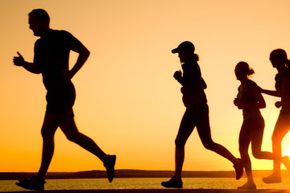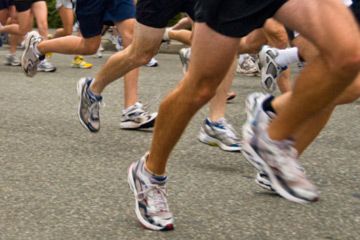It is essential to take the necessary precautions while exercising during the summer months. The average person can take from one to two weeks to adapt to warmer, more humid temperatures. Here are some helpful safety tips to follow while exercising during the summer:
Rehydrate your body. While exercising in hot weather you can easily lose up to a quart of water an hour. Drink water before, during and after exercising. Since your body can only absorb 8 ounces of cold water every 20 minutes, continue to drink fluids even after you no longer feel thirsty. Sports drinks may be popular among intense exercisers, but they are not necessary and may actually absorb more slowly than plain water. If you prefer the taste of these drinks, try diluting them with water before consumption for easier rehydration.
Advertisement
Avoid working out during peak hours. Very hot and humid weather hampers perspiration's ability to cool your body. Try exercising in the morning or evening to avoid the most intense heat as well as the times when smog and pollution levels are highest. Or consider exercising indoors at the local YMCA, health club or shopping mall.
Try walking. Walking is considered the most popular exercise among Americans. Invest in a good pair of walking shoes with a flexible sole, and good heel and arch support. It may be the only equipment you'll need. Gently stretch for five minutes before starting your walk. When you are finished walking, cool down for five minutes by gently walking and stretching for another five minutes to prevent soreness.
Be open to new ideas. Try a new exercise or activity every two weeks, such as hiking, canoeing, rollerblading or biking. These activities will allow you easy access to water or rest.
Cool off in the water. Swimming is an excellent way to exercise during the summer months. There is no need to be a good swimmer to benefit from water exercise. Performing strokes such as the backstroke or doggie paddle at the shallow or deep end of the pool still counts as aerobic exercise.
Don't forget your sunscreen. Apply SPF 15 sunscreen at least 30 minutes before exercising outdoors. Protect your eyes with sunglasses that block the sun's UV rays. Exposure to direct and indirect sunlight over many years increases your risk of developing skin cancer.
Watch out for the symptoms of heat stroke. When the body can't rid itself of excess heat, there can be a sudden rise in body temperature. Look for very hot and dry skin, dizziness, nausea, confusion and unconsciousness. Remember, these symptoms can appear rapidly. If these conditions exist, move the person to a cool area or immerse him or her in a cool bath to lower the body temperature as quickly as possible. You can also pour cool water over the person. Seek medical attention immediately; heatstroke can be fatal.
Choose the appropriate clothing. Wear loose-fitting clothing to allow circulation of air between your skin and the environment. Also, light-colored clothing will reflect sunlight, while darker clothing will absorb the heat. Cotton and linen are natural fabrics that may absorb moisture (sweat). However, synthetic fabrics that have a mesh-like weave will allow moisture to be whisked away from your skin.
Advertisement

